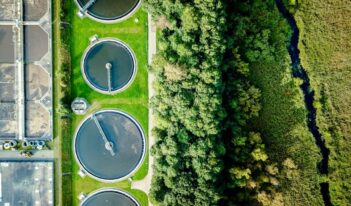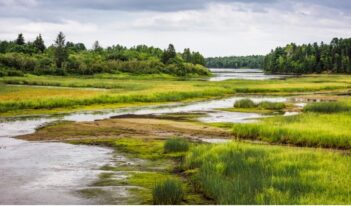
To save a natural treasure, Florida should institute stricter TMDLs to reduce fertilizer runoff.
Florida’s Indian River Lagoon, which Rep. Patrick Murphy (R-FL) has described as the “most bio-diverse estuary in the continental United States,” plays a vital role in supporting an $840 million local economy that supports 27,000 jobs. Yet the lagoon and its more than 4,300 plant and animal species face serious danger. In addition to leakage from septic tanks and local runoff pollution, discharges of polluted fresh water from Lake Okeechobee plague the lagoon’s ecosystem.
In seeking to control floods, the federal government moved in to help Florida manage the unwieldy hydrology of Lake Okeechobee. The U.S. Army Corps of Engineers constructed the Herbert Hoover Dike, a series of levees, culverts, and locks to contain the lake, along with sixty-seven miles of other dikes along the lake’s southern shore. In 1931, the agency built the St. Lucie Canal, which connects Lake Okeechobee to the Indian River Lagoon and St. Lucie estuary, eventually reaching the Atlantic Ocean.
These construction projects preceded the Comprehensive Plan of 1948 which created the Central and South Florida Project for Flood Control (C&SF Project). To implement this project, the Army Corps generated a comprehensive water management plan, which the Central and South Florida Flood Control District and, later, the South Florida Water Management District (SFWMD) locally sponsored and operated.
In recent years, the Army Corps has developed a new Water Control Plan to direct the necessary discharges from Lake Okeechobee to Water Conservation Areas (WCA) and the estuaries—including the Indian River Lagoon. While the agency prioritizes discharges to WCAs, the Hoover Dike’s deterioration as well as extreme rainy seasons require that the SFWMD make multiple discharges to the estuaries each year. The Water Control Plan attempts to protect the estuaries in a number of ways, including avoiding discharging above the “biologically-derived maximum flow.”
Even with these protections, discharges to the sensitive Indian River Lagoon have resulted in serious environmental and economic effects. Because the lagoon is brackish—meaning it has a mixture of fresh and salt water—the freshwater releases cause desalinization, which affects the species that have adapted to salinity. These native species take another hit because the water from Lake Okeechobee is polluted, containing high levels of phosphorous and nitrogen, likely from agricultural and urban runoff.
Because of the desalinization and pollution, local oyster reefs in the Indian River Lagoon have lost around 350 acres. Their current mortality rate is at ninety-nine percent. In addition, seagrass beds have reached critical levels—nine parts to five parts per thousand acres. Further, the Johnson’s Seagrass, which is a threatened species that had “eighty percent recovery last year,” has returned to zero percent recovery. Local health departments warn members of the public against contacting the water due to high toxicity and blue-green algae levels. Finally, the region has witnessed a “record number of dead dolphins, dead manatees, and dead pelicans.”
Something needs to be done. However, the Clean Water Act (CWA), as interpreted by the Environmental Protection Agency (EPA), does not currently address any of the threatening discharges. Even though the CWA requires a permit to discharge “any pollutant to navigable waters from any point source,” the EPA’s water transfer rule explains that only the initial release of a pollutant into U.S. navigable waters, as a whole, requires a permit. Once in the water, the unmodified transfer of polluted water through a system of dikes does not require a permit, according to EPA. In Friends of the Everglades v. SFWMD, the Eleventh Circuit Court of Appeals upheld the EPA’s approach.
Furthermore, the CWA does not regulate most runoff pollution either. Yet at least in the short-term, the way to make improvements will be to attack not the discharges from Lake Okeechobee, but the runoff pollution that flows into the lake. Fortunately, some local governments have started to introduce fertilizer bans during the rainy season.
While fertilizer bans and other local measures seem promising, piecemeal regulation at the local level has serious limitations. The pollution threatening the Indian River Lagoon is a classic case of the “tragedy of the commons”: the incentive for each individual (or county) is to maximize the production of crops by using fertilizers, which depletes the common resource of clean water. A free rider problem arises because each individual county has the incentive to continue using fertilizers and enjoy the cleaner water resulting from other counties’ bans. To solve the pollution problem fully, each county in the region would need to ban fertilizers and enforce those bans effectively. With the kind of free rider incentives described above, adequate protection at the local level is highly unlikely.
Another avenue for regulating runoff pollution would be through state intervention establishing Total Maximum Daily Loads (“TMDL”) under the CWA. Section 303(d) of the CWA allows states to develop TMDLs in waters that are still in danger, even with technology-based permitting regulations in place. A TMDL specifies the total allowable amount of discharges both from industrial facilities and from agricultural runoff. Florida has produced TMDLs for both Lake Okeechobee and the Indian River Lagoon, but they are hardly as robust as those found elsewhere in the country, such as from the Central Atlantic’s Chesapeake Bay, which some have called “the largest and most ‘accountable’ TMDL attempted.” By following an approach like that adopted for the Chesapeake Bay, and lowering the allowable level of runoff in the lake and lagoon, Florida could better motivate reductions in fertilizer use and, therefore, reductions in runoff pollution.
However, even if Florida were to implement this solution, it would still only be attacking one underlying cause of the problem. Even if all fertilizer runoff were eliminated, the ongoing transfer of water from Lake Okeechobee would continue to desalinize the lagoon and disrupt the local ecosystem. In the long term, the State of Florida and the federal government will need to continue to re-re-engineer Florida’s waterways to find a more sustainable method of flood control.



